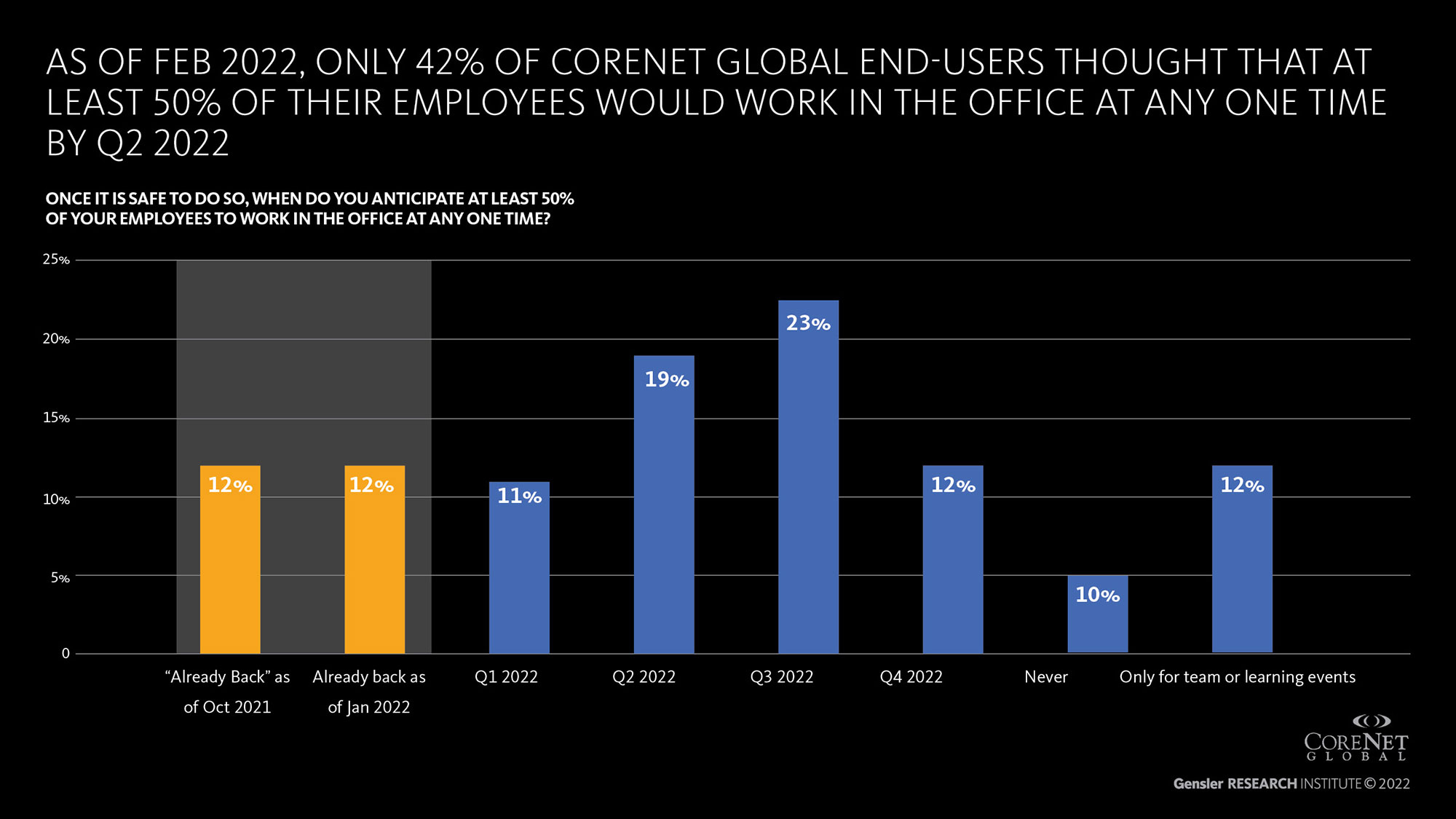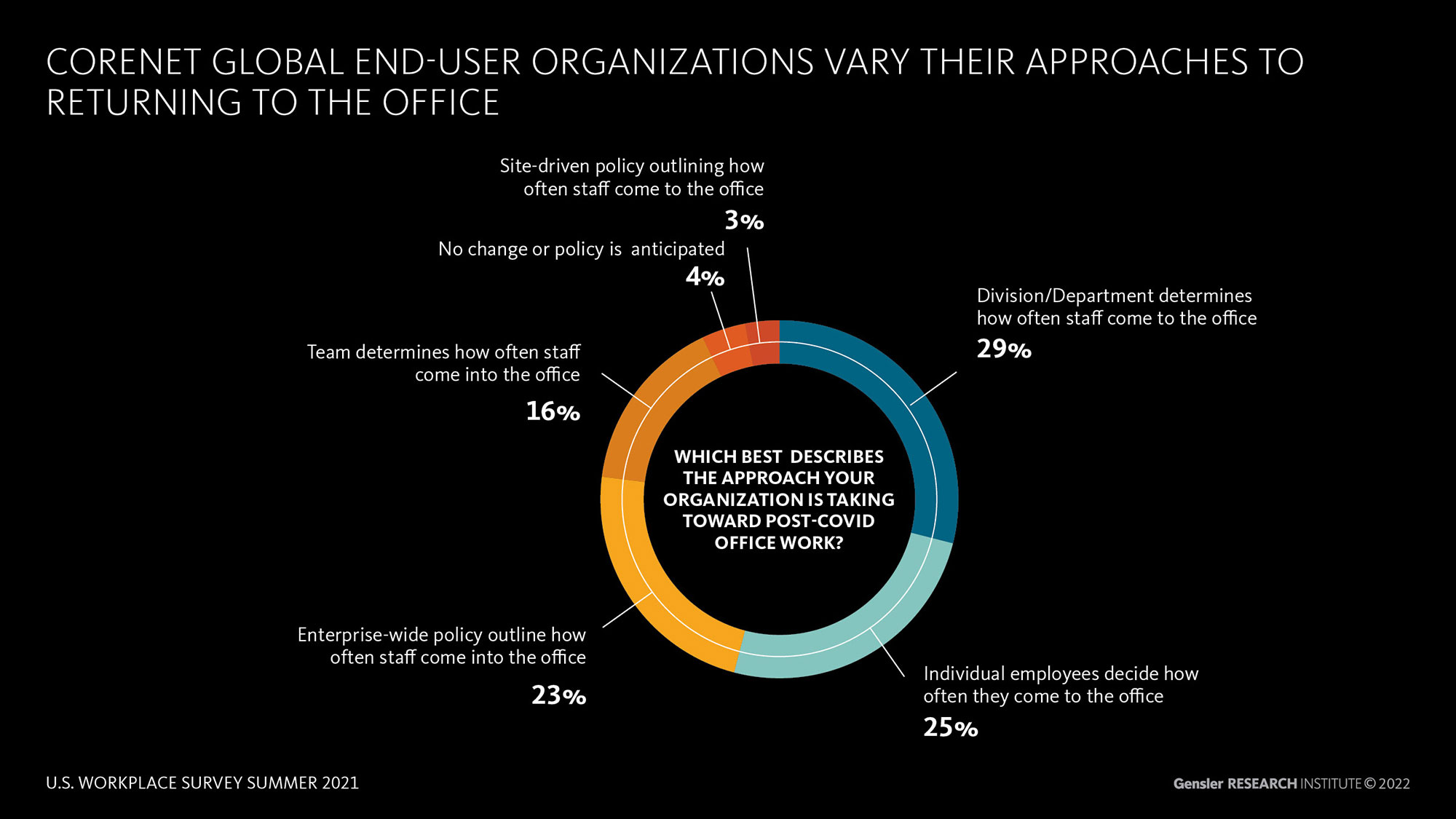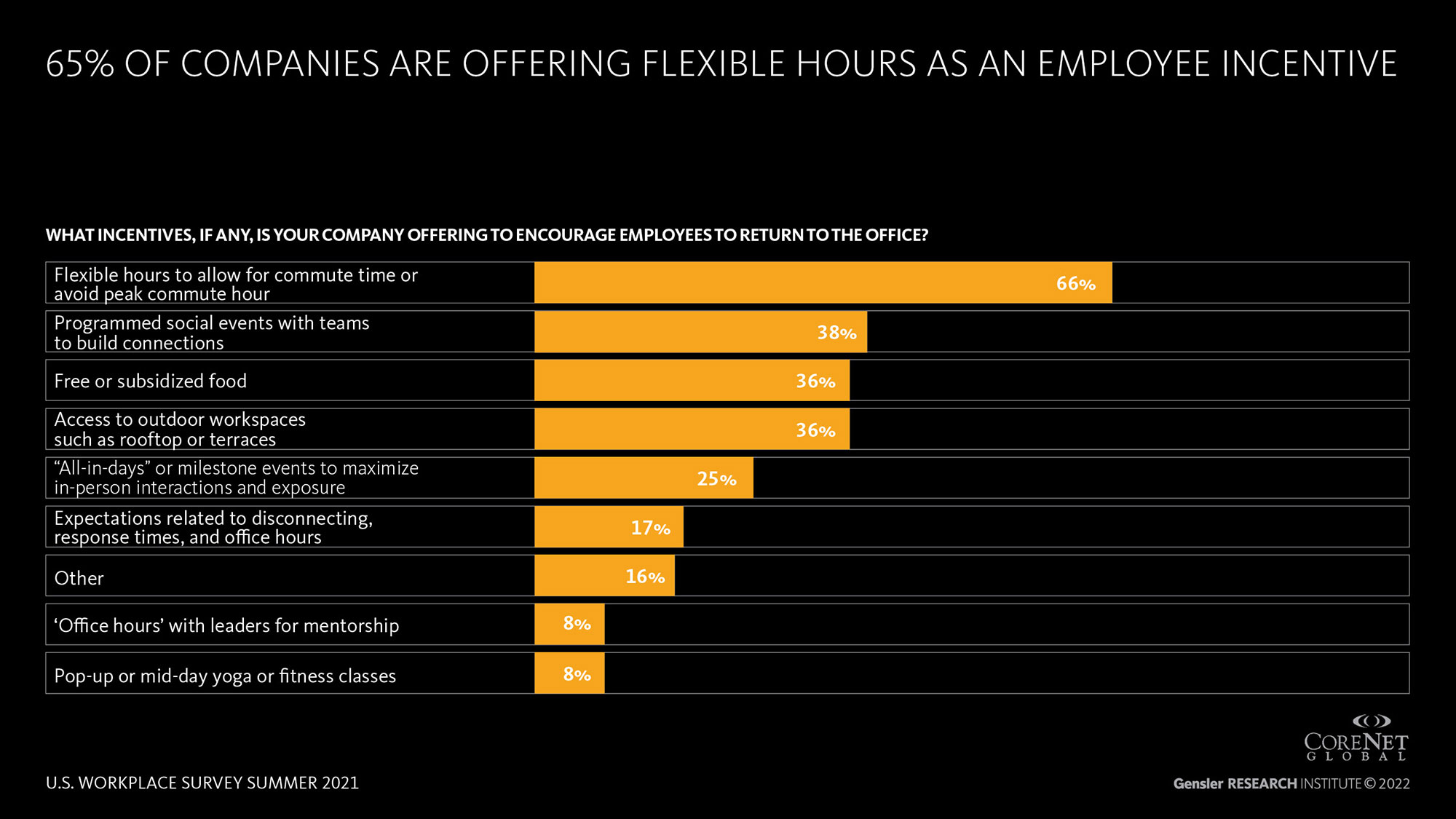How Emerging New Workplace Realities Will Drive Corporate Real Estate Strategies
April 29, 2022 | By Janet Pogue McLaurin
How many employees should we plan for? What is the new work experience that we need to create? How much and which space types will we need? And what are others doing that we can learn from? Those are the questions on the minds of most corporate real estate executives. With several false starts and stops prompted by various disruptions ranging from new coronavirus variants, to stuttered supply chains, to the uncertain future of Central Business Districts, we are all trying to learn from one another about what strategies, policies, and programs we’re planning and what we’re learning.
Gensler worked with CoreNet Global (CNG) over the last year to explore these new emerging workplace realities. We surveyed CRE end users in September 2021, live at the CNG Summit in November 2021, and again in February 2022. Coupled with what we’re learning from Gensler’s workplace research, this survey offers valuable insights in terms of the timing to return to the office, the long-term impact on real estate footprints, employer policies, what matters to employees, and advice that CRE executives would give to others.
What is the RTO timing?
The timing to transition back to the office has shifted with every new variant. At first, CRE companies were planning for a return to coincide with a return to the school year, then it was January and the start of a new year. Many offices are opening up in earnest this spring and beginning to test new, flexible policies.
In Gensler’s research, which had over 10,000 survey respondents, there was tremendous variation by industry. Some industries, such as Consumer Goods, Sciences, and Government & Defense, are either early to return or never had fully left the office due to specialized spaces, materials, and resources. Other industries, like Technology and Financial Services, transitioned easily to remote work and anticipate a higher percentage of staff to remain hybrid.
In the reality of returning to the office, we’re continuously recalibrating expectations. As of February 2022, only 42% of CoreNet Global end users thought that at least 50% of their employees would work in the office at any one time by Q2 2022. Only 12% reported that at least half of their employees were already back. This is a more conservative return than we heard at the November Summit, which was 54% by Q2.

What is the impact on corporate real estate footprints?
The U.S. Bureau of Labor Statistics reports that since the start of the pandemic, only 5.5% of businesses have cut office space, while 3.6% have increased in size. Over 90% haven’t adjusted their square footage at all, and 92.4% report that they plan to remain the same size by this time next year. But what about three years from now?
Last summer, Gensler surveyed managers, directors, and senior leaders across 10 industries and asked how the size of their real estate footprint will compare three years from now. In that survey, 44% of top-performing companies (defined as companies who reported being recently ranked on the Best Places to Work, Most Admired, and Most Innovative company lists) expected to need more real estate post-pandemic. In fact, top-performing companies were 1.5x more likely than average and 3x more likely to expect to increase their real estate footprints than unranked companies. Top-performing companies continued to onboard talent during the pandemic, and they now need a place for them to work when they return to the office. Others are now planning to build office space in new locations based on employee relocations. In either case, employers need more space.
When we polled CoreNet Global end users at the November 2021 Summit, 28% were planning to increase their real estate footprint, 23% thought it may stay about the same, and 48% were planning to reduce their footprint. In a Harvard Business Review survey published late January 2022, HBR found that companies who are shifting to hybrid work predict only a 1.4% reduction for two key reasons: if employees are on-site three days a week it doesn’t reduce office space, and employers are reshaping office to encourage face-to-face collaboration, creativity, and serendipitous interactions. This is consistent with the top purposes of the office reported by CoreNet Global end users.
What RTO policies are others planning?
Shifting expectations are influencing how employers approach RTO policies. In September, CoreNet Global end users reported that the main reasons driving their RTO policies were fairly equally divided between employee retention (30%), company culture (28%), and business performance (26%). By February, 72% of CRE executives now report that company culture is the main reason driving remote policies.

Nearly two thirds (65%) of CoreNet member organizations are offering flexible hours as an employee incentive to return to the office. These organizations also reported that by Feb. 2022, they had implemented a number of policy changes. A majority (81%) had already implemented a policy that provides individual choice and flexibility and another 14% were considering that policy. Meanwhile, 77% had already implemented providing team choice and flexibility with an additional 15% considering. Only 17% had already implemented a policy mandating specific days/times employees work in the office, but 26% were evaluating this policy. Just a quarter (25%) were considering “all-in-days” or milestone events to maximize in-person interactions and exposure.
As companies announce their new policies, there appears to be a growing preference for “core days” or “core hours” to provide flexibility and create opportunity to build the weak ties across organizations, mentor/coach younger staff, and reinforce corporate culture. Many top-performing companies have had tremendous staff growth over the last two years. Many of these new staff members have yet to come into the office to build relationships, connect with colleagues, and experience company culture.

What advice do CRE executives give others?
Cautious optimism is the industry’s current stance, and on the ground, we know that this next year will be one of experimentation, piloting, and learning. There will not be one ‘right’ answer, policy, or approach. In fact, as leaders wrestle with the right strategy for their own enterprise, there may not be a single approach that is appropriate for all sites, geographies, and functions across their organization. We may well be transitioning from enterprise-wide ‘universal planning’ to a more tailored strategy that is focused on what’s best for individuals and specific teams based on how they work best.
The human experiences missed over the last two years will bring people back to the office. A new workplace strategy is emerging that is not just focused on efficiency and space effectiveness, but one that prioritizes the whole work experience — both in and out of the office. CoreNet Global members shared their advice to other corporate real estate executives as we enter this experimentation phase. “Be flexible” topped the list, but so did “ask and listen,” “be willing to adapt,” and “remember this is a marathon, not a sprint.”
Just like the variants, there may be more starts and stops in our future. This is a time not to go back to what was, or even fix what wasn’t working pre-pandemic, but to envision a new workplace focused on people and compelling experiences where your employees want to be.
For media inquiries, email .

